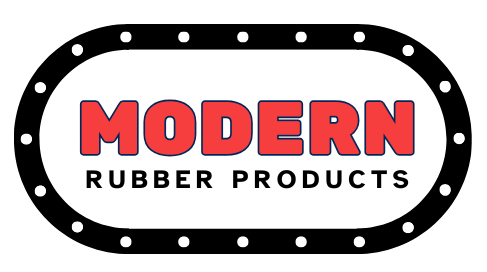
RAILWAY & MASS TRANSIT INDUSTRY
Railway & Mass Transit Industry Solutions
Modern Rubber Products delivers specialized sealing components engineered for the demanding requirements of railway and mass transit systems. Our high-performance gaskets, seals, and custom rubber components are designed to withstand extreme vibration, weather exposure, and the rigorous durability standards of public transportation infrastructure. We provide rubber solutions for passenger rail cars, locomotives, subway systems, light rail vehicles, and track infrastructure that ensure operational reliability while enhancing passenger safety and comfort. Our Chattanooga manufacturing facility employs advanced fabrication techniques to create components that maintain integrity despite constant vibration, temperature fluctuations, and decades of continuous service in critical transportation applications.

Critical Railway & Mass Transit Applications
Our rubber components serve essential functions throughout rail and transit systems, including:
- Rail car suspension and vibration isolation systems
- Door seal and window gasket assemblies for passenger compartments
- HVAC and ventilation system seals for passenger comfort
- Traction motor and drivetrain isolation mounts
- Pantograph and electrical system insulation components
- Track infrastructure components including rail pads and fastening systems
- Gangway connection seals between rail cars
- Custom fabricated components for specialized rolling stock applications

Rubber Engineered for Transportation System Performance
Modern Rubber Products manufactures a comprehensive range of sealing solutions specifically designed for railway and mass transit operations. Our components are produced using materials selected for their documented performance in the challenging rail environment. We utilize advanced elastomers including EPDM, natural rubber, neoprene, and specialized compounds formulated to withstand constant vibration, weather extremes, and electrical isolation requirements. Our engineering team ensures each component meets transit authority specifications and industry standards while delivering consistent performance throughout decades of service life.
Meeting the Unique Challenges of Rail Transportation
Railway and mass transit applications present unique demands for rubber components, requiring materials and designs that ensure both reliability and safety in public transportation systems. At Modern Rubber Products, we understand these specialized needs:
Material Selection for Operational Reliability
Rail systems require rubber components that maintain their properties despite harsh operating conditions. Our railway industry products are manufactured using compounds specifically formulated to withstand:
- Constant vibration from wheel-rail interactions
- Extreme weather exposure from desert heat to arctic cold
- Ultraviolet radiation and ozone exposure
- Electrical isolation requirements for powered systems
- Oil and hydraulic fluid exposure in mechanical systems
- Flame-retardant requirements for passenger safety
Precision Manufacturing for Critical Systems
Transit components must provide reliable performance while meeting tight safety specifications. Our manufacturing capabilities, including compression molding and waterjet cutting, produce components with exact specifications and tolerances required for proper installation in rail vehicles, track systems, and infrastructure applications.
Durability for Long Service Life
Railway rubber components must perform reliably for decades with minimal maintenance. Our solutions are engineered for exceptional longevity with properties including:
- Superior vibration damping characteristics
- Excellent compression set resistance for maintained performance
- Weather resistance for outdoor applications
- Temperature stability across climate extremes
- Flame retardant properties for passenger safety
- Resistance to oils and greases in mechanical systems
Specialized Solutions for Urban Rail Infrastructure
Modern Rubber Products supports the growing urban rail sector with specialized components designed for light rail, streetcar, and subway systems. Our urban rail-specific offerings include:
- Floating slab track isolation systems for vibration control
- Embedded rail boot systems for street-running track
- Noise-reducing rail fastening components
- Electrical isolation systems for stray current control
- Custom-designed transition components for rail crossings
Our engineering team stays at the forefront of urban rail technology developments, continuously developing new materials and designs optimized for the increased demands of modern city transit systems.
Railway & Mass Transit Industry FAQs
What rubber materials are best suited for railway vibration isolation?
For railway vibration isolation applications, we typically recommend natural rubber and specialized natural/SBR blends specifically formulated for superior vibration damping characteristics. These materials provide excellent energy absorption while maintaining their performance properties through millions of loading cycles. The specific compound and durometer hardness is selected based on the loading requirements, frequency range, and service conditions of your specific application.
Can you provide rubber components that meet rail industry fire safety standards?
Yes, we manufacture a complete range of flame-retardant elastomers that comply with EN 45545, NFPA 130, and other international fire safety standards for railway applications. These specialized compounds maintain their physical properties while achieving the flame spread, smoke density, and toxicity requirements necessary for passenger rail applications. We can help you select the appropriate material to meet the specific standards applicable to your transit system.
What is the typical lead time for railway rubber components?
For standard railway materials like EPDM and neoprene parts, we can typically fulfill orders within 2-3 weeks. Custom-cut gaskets and seals generally require 2-4 weeks depending on complexity and quantity. Specialized molded components for unique applications require additional time for tooling development, with typical lead times of 8-10 weeks for initial production. We understand the long-term planning involved in transit projects and can work with your procurement schedule to ensure timely delivery.
How do your products help reduce noise and vibration in rail systems?
Our engineered rubber components play a critical role in noise and vibration control throughout rail systems. From primary and secondary suspension elements that isolate passenger compartments from track vibration to specialized rail pads that reduce structure-borne noise transmission, our rubber solutions help transit systems meet noise regulations while improving passenger comfort. We work with transit system engineers to develop custom solutions for specific noise and vibration challenges.
What are the advantages of elastomeric bearing pads in structural applications?
Elastomeric bearing pads provide crucial benefits in bridges and buildings by distributing loads evenly, absorbing impact forces, accommodating thermal movement, and providing vibration damping. These pads prevent direct concrete-to-concrete contact that would cause wear and structural damage, significantly extending infrastructure lifespan. Our AASHTO-compliant bearing pads are engineered with the specific durometer hardness and compression properties required for your structural design loads, ensuring reliable performance throughout decades of service.
